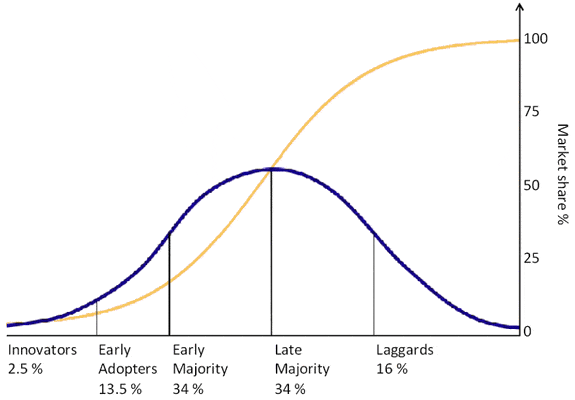The diffusion of Innovation (DOI) theory, a highly acclaimed and much-quoted academic one, was developed by E.M. Rogers in 1962 and is one of the oldest social science theories. It originated in communication to explain how, over time, an idea or product gains momentum and diffuses (or spreads) through a specific population or social system, in our case ecommerce marketing practitioners.
The result of this diffusion is how people, adopt a new idea, behaviour, or product – specifically new technology to use. Adoption means that a company does something differently than what they had previously (i.e., adoption of a new SaaS, to complement an existing stack, and thereby enjoy new new and supplementary benefits – profits, previously not experienced). The key to adoption is that the CMO must perceive the idea, behaviour, or product as new or innovative. It is through this that diffusion is possible.
Einstein’s Parable of Quantum Insanity: “Insanity is doing the same thing
over and over and expecting different results.”
Adoption of new technology, behaviour, or product (i.e., “innovation”) does not happen simultaneously in the marketing hierarchy; rather it is a process whereby some people are more apt to adopt the innovation than others. Researchers have found that those who adopt an innovation early have different characteristics than people who adopt an innovation later.
When promoting an innovation to a target population, it is important to understand the characteristics of the target population that will help or hinder the adoption of the innovation. There are five established Diffusion of Innovation adopter categories, and while the majority of the typical mêlée tends to fall in the middle categories, it is still necessary to understand the characteristics of the whole spectrum of potential users. When promoting an innovation, there are different strategies used to appeal to the different adopter categories.
- Innovators – These are people who want to be the first to try the innovation. They are venturesome and interested in new ideas. These people are very willing to take risks and are often the first to develop new ideas. Very little, if anything, needs to be done to appeal to this sector.
- Early Adopters – These are people who represent opinion leaders. They enjoy leadership roles and embrace change opportunities. They are already aware of the need to change and so are very comfortable adopting new ideas. Strategies to appeal to this population include how-to manuals and information sheets on implementation. They do not need information to convince them to change.
- Early Majority – These people are rarely leaders, but they do adopt new ideas before the average company. That said, they typically need to see evidence that the innovation works before they are willing to adopt it. Strategies to appeal to this population include success stories and evidence of the innovation’s effectiveness.
- Late Majority – These people are skeptical of change, and will only adopt an innovation after it has been tried by the majority. Strategies to appeal to this population include information on how many other people have tried the innovation and have adopted it successfully. Those in this sector like to believe that they already have something that does the same thing, their reticence is apparent in lower growth rates and diminutive profit results.
- Laggards – These people are bound by tradition and are very conservative. They are very sceptical of change and are the hardest group to bring on board. Strategies to appeal to this population include statistics, fear appeals, and pressure from people in the other adopter groups. Naturally, these tend to include those who, but for better advice, have financial problems and suffer poor results after poor results. While this is a reflection on the company, it should be noted that inclusion in this group could equally be caused by a misplaced reliance on recalcitrants – that can’t see an opportunity if it is staring them in the face, often not appreciated by the ecommerce retailer until it’s too late.

The stages by which an ecommerce retailer adopts an innovation, and whereby diffusion is accomplished, include awareness of the need for an innovation, decision to adopt (or reject) the innovation, initial use of the innovation to test it, and continued use of the innovation. Five main factors influence the adoption of an innovation, and each of these factors is at play to a different extent in the five adopter categories.
- Relative Advantage – The degree to which an innovation is seen as better than the idea, program, or product it replaces.
- Compatibility – How consistent the innovation is with the values, experiences, and needs of the potential adopters.
- Complexity – How difficult the innovation is to understand and/or use.
- Trialability – The extent to which the innovation can be tested or experimented with before a commitment to adopt is made.
- Observability – The extent to which the innovation provides tangible results.
Limitations of the Diffusion of Innovation Theory
There are several limitations of Diffusion of Innovation Theory, which include the following:
- Much of the evidence for this theory, including the adopter categories, did not originate when ecommerce existed and it was not developed to explicitly apply to the adoption of new technology innovations.
- It does not foster a participatory approach to the adoption of ecommerce programs specifically.
- It works better with the adoption of behaviours rather than cessation or prevention of behaviour.
- It doesn’t take into account an individual’s resources or available support to adopt the new technology.
This theory has been used successfully in many fields including communication and ecommerce. The latest technology to fall into this predicament is hyper-personalisation software. This personalises what products are selected to be presented to each consumer at the perfect time, based on their impressions, buying history and the customer journey of that individual, before competitor sites are even aware of this opportunity.
There are two contributing factors to this, which are:
i. Are an established dominant plethora of old tech providers all of whom don’t want to lose custom, and are vehemently trying to persuade the market that what they market, does the same thing.
ii. The other group is dominated by consultants and developers who are focused on new clients’ gains and servicing existing requirements, they prefer to wait to see established company adoption, rather than feel it is their responsibility to bring it to their client’s attention urgently.
Reinvention is a fundamental concept in the Diffusion of Innovation Theory. The effectiveness of a new idea relies on its ability to adapt and satisfy the increasing needs of individuals who are more cautious and have higher expectations within a group (the evolution of mobile phones serves as a prime illustration).
One effective strategy is to involve users as collaborators in an ongoing cycle of improvement. Companies that develop computer games, pharmaceutical firms, and research centres in rural areas are examples of entities that aim to engage users as active contributors to the enhancement of ideas by backing user groups or by utilizing methods of collaborative research.
A lot of video games are now designed to allow players to make changes and improvements themselves. According to Francine Gardin, an expert in how consumers behave, “Players are involved in creating the game. They’re deeply committed to the game – it’s almost like a community. They feel a strong sense of belonging and control over that brand.
Rather than being dissatisfied, they take it upon themselves to fix the issues.” The idea of making something new again is crucial as it shows us that no product or method can become complacent: ongoing enhancement is essential for sharing a new idea.
When a new idea moves from its initial supporters to the wider public, in-person interaction becomes increasingly crucial in the choice to embrace it. This concept is demonstrated in the Bass Forecasting Model (shown below), which shows the increasing importance of in-person interaction as time goes on, and the diminishing impact of mass media.





